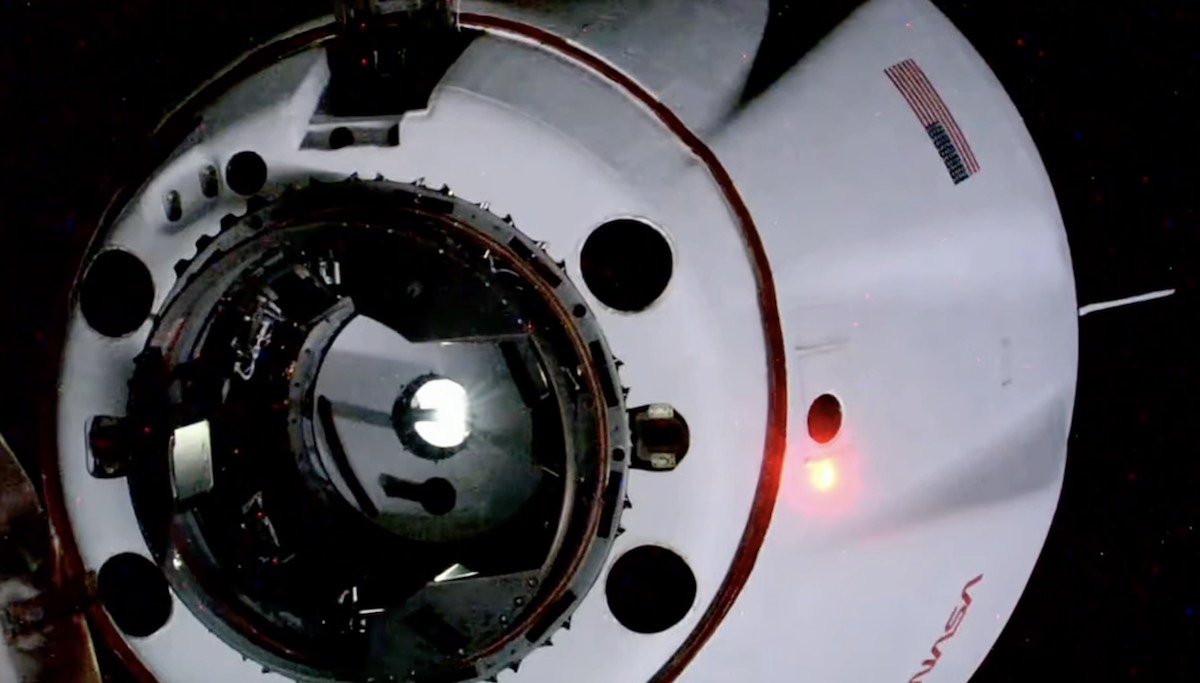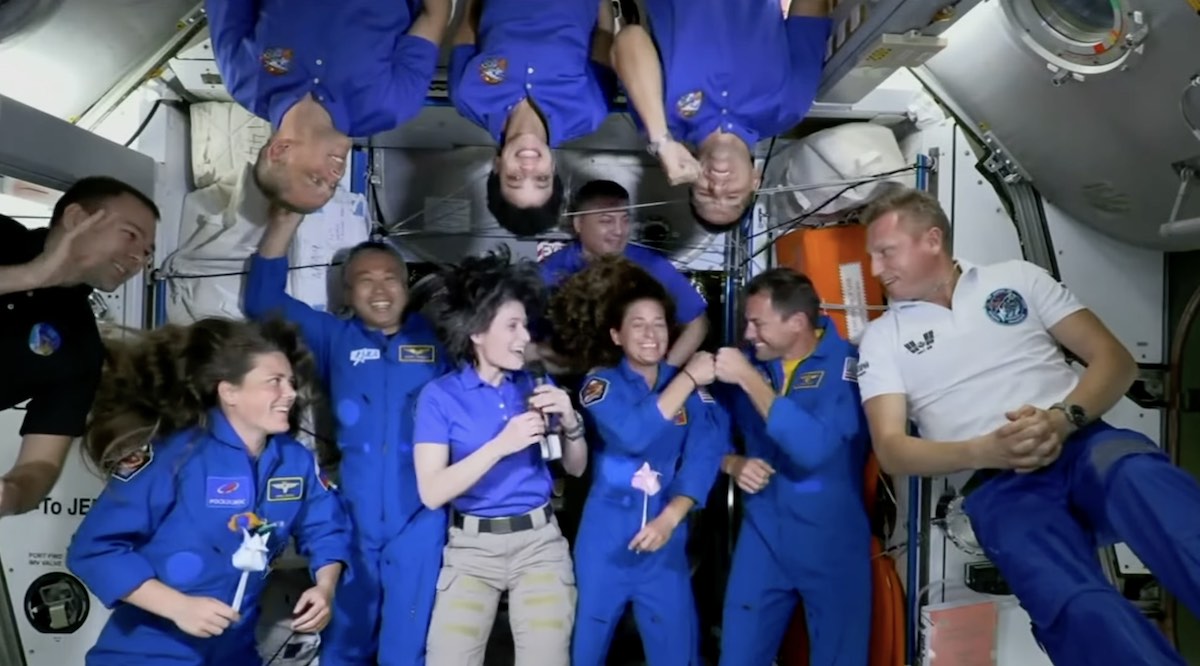Space News & Blog Articles
Dragon crew capsule delivers four new residents to International Space Station
 SpaceX’s Dragon Endurance spacecraft on final approach to the International Space Station. Credit: NASA TV / Spaceflight Now
SpaceX’s Dragon Endurance spacecraft on final approach to the International Space Station. Credit: NASA TV / Spaceflight Now
SpaceX’s four-person Dragon Endurance crew capsule arrived at the International Space Station Thursday, delivering U.S., Japanese, and Russian crew members to the complex and replacing four astronauts scheduled to conclude their long-duration science mission next week.
The crew capsule glided to an automated docking with the forward port of the space station’s Harmony module at 5:01 p.m. EDT (2101 GMT) Thursday, completing a 29-hour transit from a launch pad at NASA’s Kennedy Space Center in Florida.
About two hours later, Dragon commander Nicole Mann, pilot Josh Cassada, and mission specialists Koichi Wakata and Anna Kikina floated into the space station to greet the seven astronauts and cosmonauts already living and working aboard the outpost. Their arrival temporarily boosts the station crew size to 11 people.
Kikina is the first Russian cosmonaut to fly on a SpaceX crew capsule, and the first Russian to launch on any U.S. rocket since 2002.
The arrival marked the fifth docking at the space station of an operational SpaceX crew rotation mission under a multibillion-dollar crew transportation contract with NASA. This mission, known as Crew-5, launched Wednesday on top of a Falcon 9 rocket from Kennedy to begin a planned five-month research expedition on the station.
European Space Agency astronaut Samantha Cristoforetti, commander of the space station’s Expedition 68 crew, welcomed Mann, Cassada, Wakata, and Kikina to the research lab.
“This is a very special crew because it’s the first time that we have a Russian cosmonaut flying on a Crew Dragon, so a very special welcome to Anna, who broke the ice on this crew swap that is so important for the resilience and the robustness of our operations on the space station,” said Cristoforetti, an Italian-born astronaut and the first woman from ESA’s astronaut corps to command a space station crew.
Kikina was confirmed as the fourth crew member for Crew-5 mission in July, when NASA and the Russian space agency, Roscosmos, finalized a “seat swap” agreement enabling Russian cosmonauts to launch and land on U.S. crew capsules and U.S. astronauts to fly to the space station on Russian Soyuz missions.
The seat sharing agreement is intended to ensure the space station is always staffed by at least one U.S. and one Russian crew member, allowing each country’s segment of the complex to remain fully operational even if there was a major problem or delay in U.S. or Russian crew launches.
The agreement is also designed to protect against the risk of a medical emergency forcing the evacuation of an entire Russian Soyuz or U.S. spacecraft crew. If that happened, at least one U.S. or Russian crew member would still remain on the station.
NASA astronaut Frank Rubio launched to the space station Sept. 21 on a Soyuz spacecraft, alongside Russian cosmonauts Sergey Prokopyev and Dmitry Petelin.
“With the flight of Soyuz and flight of Crew-5, we will start what we call integrated crews, or exchange flights, when one crew member from the Russian segment will fly on an American vehicle and one American will fly on a Russian vehicle,” said Sergei Krikalev, a veteran cosmonaut and executive director of human spaceflight programs at Roscosmos, Russia’s space agency.
“This type of exchange will increase the robustness of our program, and we will continue this practice to make our program more reliable,” Krikalev said.
Mann, a U.S. Marine Corps colonel and former F/A-18 fighter pilot, led the team of four on the Crew-5 mission to the station. She is the first woman to command a SpaceX Crew Dragon mission, and the first Native American woman to fly in space.
She is from California and earned degrees in mechanical engineering from the U.S. Naval Academy and Stanford University. Mann, 45, is registered with the Wailacki of the Round Valley Indian Tribes, and said before the launch she planned to fly in space with a dreamcatcher given to her by her mother.
The pilot on the Crew-5 mission is Josh Cassada, 49, a former P-3 and P-8 aircraft pilot in the Navy. He was born in San Diego and considers White Bear Lake, Minnesota, as his hometown.
Mann and Cassada were selected as NASA astronaut candidates in 2013, and previously assigned to train for missions on Boeing’s Starliner spacecraft. After the Starliner program encountered delays, NASA reassigned Mann and Cassada to a SpaceX mission so they could fly to space sooner. They became the last members of their astronaut class to launch into orbit.
Koichi Wakata, a Japanese astronaut, arrived with the Crew-5 mission to start his third long-duration stay at the space station. It is also his fourth overall visit to the orbiting complex, including a space shuttle mission to help assemble the station in 2000. The Crew-5 mission is his fifth spaceflight overall.
Wakata earned a doctorate in aerospace engineering from Kyushu University in Japan, and was selected as an astronaut candidate by Japan’s space agency in 1992. The 59-year-old has logged 347 days in orbit on four previous missions, and could become the most experienced space flier not from the United States or Russia by the end of the Crew-5 mission early next year.
 Crew-5 commander Nicole Mann and pilot Josh Cassada exchange fist bumps after arriving on the International Space Station. Mann and Cassada are the last members of their 2013 astronaut class to reach space. Credit: NASA TV / Spaceflight Now
Crew-5 commander Nicole Mann and pilot Josh Cassada exchange fist bumps after arriving on the International Space Station. Mann and Cassada are the last members of their 2013 astronaut class to reach space. Credit: NASA TV / Spaceflight Now
Kikina is a 38-year-old engineer and the only woman currently active in Russia’s cosmonaut corps. She graduated from Novosibirsk State Academy of Water Transport before her selection as a cosmonaut in 2012.
She initially trained to launch fly on a Soyuz spacecraft, then started preparing for a possible flight on a SpaceX Dragon capsule last year. She trained for several months for the Crew-5 mission before her assignment was finalized in July.
“My leaders pointed at me and told me do you want to be part of Crew-5,” Kikina recalled. “Yes, why not! But I was so surprised. It was, for me, not expected. After that, everything began very fast.”
Kikina’s duties on the space station will include operating the European robotic arm from a control panel inside the Russian section of the outpost. She is also certified for spacewalks using Russian Orlan spacesuits, but has no spacewalks currently planned during her stay in orbit.
With the docking of the Crew-5 mission, the next major event on the space station’s flight plan will be the departure of the Crew-4 mission. Cristoforetti will hand over command of the station to Prokopyev before returning to Earth on SpaceX’s Dragon Freedom spacecraft with NASA crewmates Kjell Lindgren, Bob Hines, and Jessica Watkins.
They have been living on the station since April.
The Crew-4 astronauts are tentatively scheduled to undock from the station on SpaceX’s Dragon Freedom capsule next Wednesday, Oct. 12, to head for splashdown off the coast of Florida on Oct. 13. NASA and SpaceX officials could adjust that schedule based on weather and sea conditions in the splashdown zones in the Atlantic Ocean and Gulf of Mexico.
This email address is being protected from spambots. You need JavaScript enabled to view it. the author.
Follow Stephen Clark on Twitter: @StephenClark1.
When you subscribe to the SpaceZE News Feed, we will send you an e-mail when there are new updates on the site so you wouldn't miss them.

